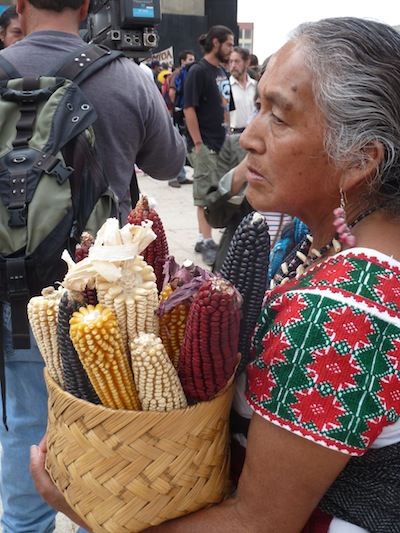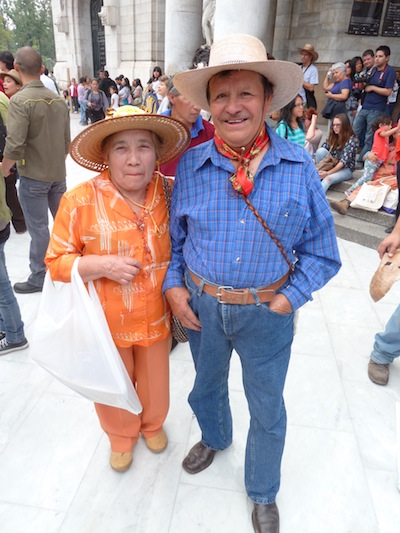
On May 25, an estimated two million people across 50 countries participated in the global March Against Monsanto. Organizers estimate that these protests against the U.S.-based transnational biotech corporation were one of the largest days of coordinated action in history. Yet, despite the high level of coordination, the local actions were not all orchestrated by professional organizers — and nor were the resulting actions all traditional marches.
On Saturday, about 2,000 participants gathered in Mexico City for the Carnaval del Maíz, a “Carnival of Corn” to celebrate Mexico’s rich diversity of native corn, threatened by Monsanto’s plans to introduce a genetically modified variety of the crop. The fact that Mexico’s manifestation of the global March Against Monsanto took the form of a carnival is no coincidence. The current generation of Mexican activists is looking for new strategies to fight for social justice, and the March Against Monsanto provided an opportunity to fuse tradition and innovation into the building blocks for a global food revolution.
The beginnings of the action came from an unlikely source: a novice Mexico City activist named Thalía Güido. In early March, Güido found the “March Against Monsanto” Facebook page and learned there was to be a global protest on May 25.
“I started to see [actions] in Africa, in Boston, and I said to myself, how can it be that Mexico isn’t listed?” she remembered thinking. After the organizers confirmed that there was nothing yet planned for Mexico, she decided it was time to start planning.
She started by contacting student-activists who had belonged to her university’s chapter of Yo Soy 132, a movement that opposes Mexican President Enrique Peña Nieto and the nation’s corporate media conglomerate. They liked the idea, so she began reaching out to other organizations.
“I started sending emails like crazy,” said Güido.
The momentum began building. At the first meeting, there were four participants; by the fourth, the group barely fit in the room. By the week before the event, more than 40 different organizations, as well as independent activists, were involved in the organizing efforts — although no one wore name tags identifying what institution they were coming from. Güido attributes the rapid growth of the planning meetings to the horizontal and citizen-oriented structure of the group, as well as to the carnivalesque nature of the event.
“The truth is I don’t want to be an ‘official organizer,’” Güido often told the others. “I want this to grow as a citizen initiative.”
Celebrating subversion
Another reason the event attracted so much participation is because the target —Monsanto — is one of the largest and most reviled corporations in the world. The global scale of last Saturday’s event reflects the far-reaching influence of and animosity toward Monsanto, which is embroiled in controversies around patent litigation, health concerns, environmental destruction and small farmer oppression.
Yet, the corporation’s presence is particularly threatening in Mexico, where much of the rural culture centers on corn production. “It affects everything because our culture revolves around corn,” said farmer and activist Héctor Mendoza Rosas. “And with GMOs what you would have to do is, you wouldn’t be selecting seed, you would be buying it. You wouldn’t be saving seed. You’d have to by all of their stuff.”

This threat to Mexico’s rural agricultural economy and sustainability isn’t new. Since the North American Free Trade Agreement went into effect in 1994, cheap corn from the United States has undercut small Mexican farmers’ ability to make a living while maintaining the traditional practices that preserve Mexico’s cultural and biological diversity. But today’s plans to introduce a genetically modified crop threatens the very global future of the crop’s genetic diversity because Mexico is, organizers explained, “the center of origin and diversification of corn.”
Monsanto’s presence in Mexico is also seen as an attack, particularly on the nation’s pre-Hispanic cultural values. “There is a very strong nationalism in Mexico based on a mythology,” explained carnival organizer Paula, who chose to share only her first name. “It has always been said that in one way or another, Mexicans come from corn.”
The idea for a carnival stemmed from the organizers’ understanding of this pre-Hispanic culture, known as indigenismo, in which these festivals represent challenges to the ruling power.
“The carnival in Mexico is subversive,” said Carlos Ventura Callejas. He explained that in the aftermath of the Spanish conquest, indigenous communities used the carnival as a way to preserve traditional religious cultures in the face of imposed Catholicism.
“Carnival time is a time to go out and think things that the system doesn’t allow you to think,” said Ventura.
So, organizers thought: What better way to go to battle against Monsanto than by having a Carnival of Corn?
A break from marches
The idea of organizing a carnival instead of a traditional political march was also a strategic decision.
“Something I’ve realized since getting more involved in Yo Soy 132 is that protest is now seen as something obsolete,” explained Güido. “So it really has to do with a redefinition, with a change in concept. We’re going to put on a march, but we’re going to do it with a playful theme instead of making it combative… We’re going to have creative spaces for artists.”
The strategic emphasis on creating a playful and festive space was, in part, a reaction to the ugly street scene on the day of Enrique Peña Nieto’s inauguration, when thousands massed to protest the presidential imposition. Many of the people involved in organizing the Carnival for Corn remember the bitterness that exploded that day, and both Güido and Ventura saw it as a reason to organize a joyous carnival — especially since the government subsequently rewrote the police protocol for demonstrations, resulting in what Güido described as “an impressive criminalization of protest.”
The organizations and individuals involved in the planning sessions set about filling the day’s itinerary with theater, workshops, music and art, permeating the day’s scheduled march and speeches with carnivalesque activities. The organizers also deployed social media and their own livestream channel to spread the word. The message focused on the global aspect of the day of action.
At the Carnival of Corn’s press conference two days before the event, Paula began by declaring that the carnival would allow Mexico to “unite our voices” with those in more than 400 cities around the world. Then, on Saturday, the livestream group 5oymexico.org began broadcasting hours before the event in Mexico City began so that they could share video, images and audio from anti-Monsanto actions in places where the protests had already begun.
The carnival begins
The Carnival of Corn was, at its core, a celebration of Mexican agricultural heritage. Children made seed bombs, known in Spanish as bolitas de vida, out of clay, soil and amaranth seeds.

Hundreds participated in a play written by a local playwright that showcased the importance of corn in Mexico and drew a parallel between traditional mythological characters and modern-day actors. Organizers distributed masks and audience-members-turned-actors assumed the role of either Olmecs, an ancient indigenous people from southern Mexico, or the minions of Tlaltecuhtli, pre-Hispanic god of the dead. A figure playing Monsanto used the death-minions to steal native corn from the Olmecs, but in the end the community organized to defeat him.
Throughout the day, artists used performance and creativity to inform the carnival’s estimated 2,000 participants about Monsanto. A theater troupe from nearby San Miguel de Allende performed a show illustrating the dangers of Monsanto’s genetically modified crops and the corporation’s business practices. As performer Diana Hoogesteger explained, “Theater is a way to get people to notice you. Once they see you, they listen, and then they can be informed in an entertaining way of the things that are happening in the world.”
The carnival attracted both city residents and small farmers from nearby rural communities who saw Monsanto’s presence as a threat to their very livelihood. One participant, Delfino Santillán Castillo, traveled from Zupango, a region about an hour outside of Mexico City. He lamented that he now has trouble selling the native corn seed that he saves every year. He wife also expressed fear, particularly over Monsanto’s exclusive patents.
“If a Monsanto seed ends up on our land… they will sue us and take away everything we have,” she said.

The two heard about the action through a community radio program that had interviewed one of the Carnival’s organizers. Castillo explained that they prefer the radio over corporate news stations. “The television doesn’t tell the truth,” he said. “It just speaks in favor of the government and nothing else interests it.”
The day also attracted people from activist organizations, such as Guillermo Rizo Ornelas, who works with Ecos del Buen Vivir, an organization dedicated to environmental justice, human rights, education and health issues. He called on the government to practice the precautionary principle — the idea that precautionary measures should be taken with potentially harmful activities even if the harmful effects have not yet been clearly proven.
After marching to the Monument to the Revolution in downtown Mexico City, the local Food Not Bombs chapters collaborated to nourish the hungry protesters, who continued talking, laughing and performing as they shared what the March Against Monsanto is finally all about: a meal. Presentations by various organizations followed, as well as music by artists including Roco, from one of Mexico City’s most famous urban bands, Maldita Vecindad.
At the end of the day, Thalía Güido’s speech echoed what she had expressed throughout the planning process.
“This isn’t just a crossroads here in Mexico,” she told journalists. “We’ve created a worldwide network of communication between movements, organizations, people — between everyone who is in favor of the freedom of food and food sovereignty. So we believe that this is really part of a food revolution.”
Organizers have not yet planned their next action, but they have their eyes on even more symbolic date: September 29, Mexico’s National Day of Corn.

I am so glad you are standing strong but taking a nonviolent stand. Thank you!
It’s so great to read about this creative protest against Monsanto, and to get a sense of the organizing that went into it. I’m glad to see that this is considered to be part of a global movement for food sovereignty, and that there’s been good communication between movements and organizations. I’m curious to see how this develops, see what steps other groups start taking, and see what happens on September 29th. Bravo!